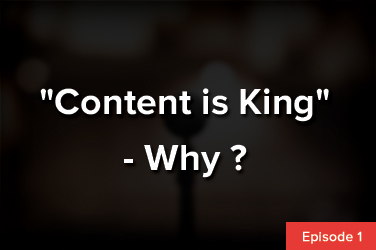4 Ways to Stop Burning Money in Ads but Still Get More Customers?
The eternal trick of marketing hits especially hard for startups and small businesses. How can you promote your business effectively, despite a limited budget? If you’re not careful, embracing advertising means little more than burning through your marketing budget without having much to show for. But that doesn’t have to be the case. In fact, […]
-
The eternal trick of marketing hits especially hard for startups and small businesses. How can you promote your business effectively, despite a limited budget?
-
If you’re not careful, embracing advertising means little more than burning through your marketing budget without having much to show for. But that doesn’t have to be the case. In fact, here are 4 ways you can stop burning your money in ads, and still increase your customer base.
1) Embrace Content Options
First things first: rather than spend money to push your message to an audience that simply might not care, draw in the users that matter to your content. That’s the philosophy behind content marketing, a concept that has built significant momentum in the past few years.
Global internet users are tired of outdated marketing tactics. They are installing ad blockers by the hundreds of millions, actively steering around the ads they encounter everywhere online. You may pay for that ad, but it never actually makes it in front of your audience.
Content marketing avoids that problem. If you can turn your website and online presence into a valuable resource for your audience, they will actively seek you out. Blog posts, whitepapers, webinars, and other content is effective in drawing your audience towards you.
2) Find the Free Alternatives
Not every marketing initiative you engage in actually impacts your budget. In fact, if you know where to look, you can actually promote your startup effectively while relying only on free tactics. Consider as examples:
- Search engine optimization, achieved through a strategic design of your website. Your goal is to build the structure and content of your website specifically so that it appears near the top of search results for relevant keywords and phrases for your industry.
- Organic social media marketing. Not to be confused with paid social media ads, the organic alternative means little more than building a business presence on a network relevant for your audience. Publish enough posts relevant to your audience, and your followers (and with it, brand exposure) will follow.
- Email marketing. At some point in the sales funnel, you should seek to gather the contact information of interested members of your target audience. Now, you can nurture them through emails via one of multiple free tools available to increase their chance of customer conversion.
3) Limit Your Audience
Depending on your industry, relying exclusively on free and content-based marketing strategies may not be enough. In that case, you can still make sure that your advertising dollars are well spend. All you have to do is make sure the people who see your ads are actually relevant to your brand.
Especially digital marketing has evolved significantly in its targeting capabilities. For instance, Facebook allows you to limit the users exposed to your ads by geography, age, gender, education level, interests, recent purchasing behavior, and much more.
Your message will be more likely to resonate with a relevant audience. By limiting that audience, you ensure that the marketing net you cast is at once smaller, and less likely to allow anyone to fall through.
4) Engage in Thorough Testing
Finally, no marketing strategy can be reliably successful and cost-effective without continuous testing and adjustments. If you never compare your ads to anything else, you may simply never know whether you’re only burning through your budget or actually attracting customers.
A simple way to accomplish that feat is through A/B testing. Each ad you run should exist in at least two variations (A and B). The variations should be identical, with a single element changed (such as the image, the call to action, the headline, or the text itself). Depending on which outperforms the other, you can gain insights into what types of ads your audience actually wants to see.
Testing, of course, is meaningless without actual lessons learned. After a given period, evaluate your ads, and place your budget in the variation that outperformed the other. Now, you can feel more comfortable in how your ad dollars are spent – or engage in another A/B test to further hone the message.
Startup marketing on a limited budget is far from impossible. However, you do have to be strategic in order to make it work. The above tips can help you stop burning through your marketing dollars, while still maximizing your ability to attract new customers. To learn more about startup marketing, and growing your small business in general, contact us .
Archives by Month:
March
- Why People Buy? What key factors determine they would do business with you?
- Special Guest – Raj Smriti
- Let’s catch the Thief that is stealing your success



February
January
- The 5 Sins of Marketing to avoid for success
- How to charge what you’re worth?
- Ever heard “Content is King” – Why ?



July
- 20 Myths About Business Success Revealed
- 4 Ways to Stop Burning Money in Ads but Still Get More Customers?
- What’s the Key to Creating Successful Conversion Content? and Grow Sales!
- Inbound Marketing – Perfect For People Who Hate Selling
- The Worst Advice We’ve Ever Heard About Sales





March
- What is Buyer’s Journey & Why it matters for your business?
- 4 Reasons why your Marketing efforts are not paying off or converting?
- The Benefits of Buyer Personas and How to Get Started?
- Why We Don’t Sell Any Project Without Discovery?




February
- 10 signs your website might be ready for an upgrade
- Why your business needs a technical co-founder…and where to find one?


January
December
- Startups Business – Determining if Your Business is Ready for Funding
- Five steps to attract investors
- How to Make a Successful Startup Business Plan.
- 10 Common Mistakes New Businesses Make




November
- 10 Crucial Errors to Avoid for Startup Businesses
- Spread the Word: 4 Ways to Enhance Your Online Presence
- $100 website vs a $10,000 website? What’s the difference?
- Brochure Website vs. Sales Person Website – What Really Works for You?
- $10,000?! For a website? Is a website worth that much ?











